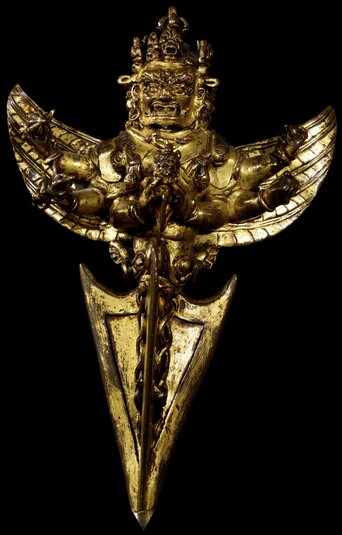
Item: Vajrakila (Eight Pronouncements)
| Origin Location | Tibet |
|---|---|
| Date Range | 1600 - 1699 |
| Lineages | Nyingma and Buddhist |
| Material | Metal, Mercuric Gild |
| Collection | Carolyn and Wesley Halpert |
Classification: Deity
Vajrakila, Heruka (Tibetan: dor je phur ba, trag tung. English: Vajra Peg, Blood Drinker) is a meditational deity of tantric Buddhism. Also known as Vajra Kumara (Vajra Youth) or Vajrakilaya, he is the activity aspect from the set of Eight Herukas (Tib.: ka gye) of the Mahayoga Tantras of the Nyingma Tradition of Tibetan Buddhism and a principal meditational deity for both the Nyingmapa and Sakyapa, later taken up by the Jonang and many of the various Kagyu Traditions.
The study of Vajrakila can be divided into three major subjects: (1) the early Nyingma and Sakya Traditions, (2) the later 'Revealed Treasure' (Terma) traditions and (3) the Purba Drugse Chempa of the Bon Religion
Vajrakila is typically wrathful in appearance, blue in colour with three faces, six arms, four legs and surrounded by the flames of pristine awareness. A pair of wings are unfurled behind. The first pair of hands hold a vajra peg at the level of the heart. The right hands hold a five and nine pronged vajra scepter. The two left hands gold a trident and a mass of flames.
This form of Vajrakila has a three bladed peg as a lower body. The peg extends downward from the gaping mouth of a makara (water monster). Coiled naga tails further adorn the length of the blades. Generally this deity form is found as one of four outer retinue figures in the mandala of Vajrakila and occupying the four corners. A kila peg generally has one of two functions. Either the peg is used in the construction of a three-dimensional mandala as a utilitarian tool to secure the surrounding space in preparation for a sanctification ritual, or the peg is placed inside the mandala to represent either the central figure or one of the retinue figures of the deity mandala. It is most likely that the image of a peg above is used as a ritual piece to represent the deity or retinue and would typically be kept on a temple shrine or personal shrine in a home.
The object was cast in different sections and then assembled and fixed as a single object. The surface has been treated with mercuric guilding. The condition of the piece is good with the usual amount of wear and abrasions typical of an object of its age. There are very few examples of this sculptural figure known which makes the object somewhat rare making it hard to compare with other similar objects.
Jeff Watt 11-2019
Collection of Caroline & Wesley Halpert
Ritual Object: Kila 'Purba' (Masterworks)
Sculpture: Metal
Collection of Halpert (Sculpture)
Ritual Object: Kila 'Purba' Main Page
Sculpture, Metal: Buddhist Deities
Buddhist Deity: Vajrakila Main Page
Buddhist Deity: Vajrakila (sculpture)
Ritual Object: Kila (Masterworks)
Ritual Object: Kila 'Purba' (Vajrakilaya)
Subject: Masterworks (Miscellaneous Topics, 多種科目)
